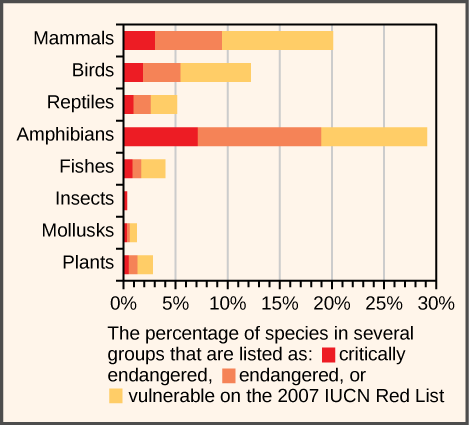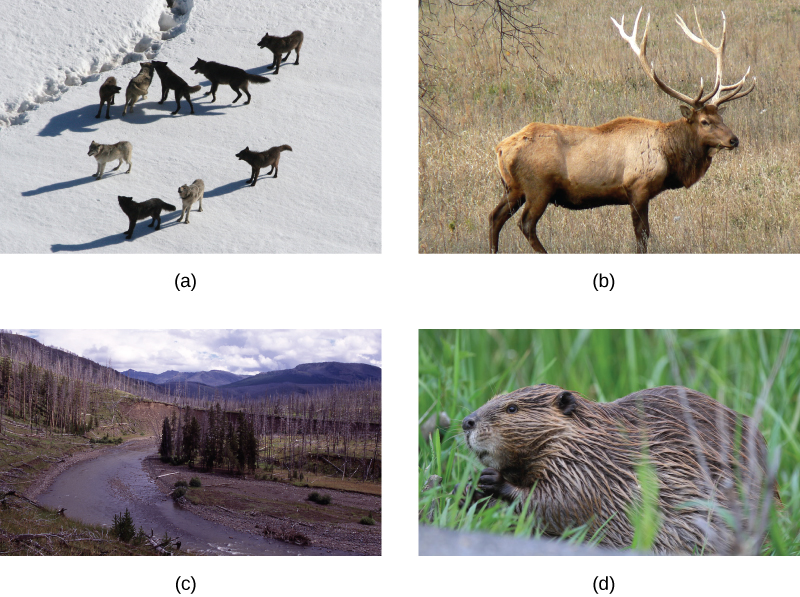47.4: 保护生物多样性
- Page ID
- 202922
培养技能
- 确定描述生物多样性的新技术
- 解释保护的立法框架
- 描述保护区设计的原则和挑战
- 找出栖息地恢复影响的例子
- 讨论动物园在生物多样性保护中的作用
保护生物多样性是一项非同寻常的挑战,必须通过更好地了解生物多样性本身、人类行为和信仰的变化以及各种保护策略来应对这一挑战。
测量生物多样性
分子遗传学和数据处理与存储的技术正在成熟,以一种易于使用的方式对地球物种进行分类几乎是可行的。 DNA条形码是一种分子遗传方法,它利用真核生物(植物除外)中存在的线粒体基因的快速进化,使用该基因部分的序列来识别物种。 可以使用叶绿体基因的组合对植物进行条形码。 快速大规模测序机使这项工作的分子遗传学部分相对便宜且快速。 计算机资源存储并提供大量数据。 目前正在开展项目,使用DNA条形码对博物馆标本进行编目,这些标本已经被命名和研究,并在研究较少的群体中测试该方法。 截至2012年年中,已有近15万个命名物种被条形码。 早期研究表明,有大量未描述的物种看起来过于像兄弟物种,以前被认为与众不同。 现在可以用 DNA 条形码来识别它们。
现在,许多计算机数据库提供有关命名物种的信息和添加新物种的框架。 但是,正如已经指出的那样,按照目前对新物种的描述速度,要知道完整的生命目录将需要将近500年的时间。 地球上的许多,也许是大多数,物种没有那么多时间。
还有一个问题是要了解科学界已知的哪些物种受到威胁以及它们在多大程度上受到威胁。 这项任务由非营利组织 IUCN 执行,如前所述,该组织维护着 “红名单”,这是一份按分类法、威胁类型和其他标准分类的濒危物种的在线清单(图\(\PageIndex{1}\))。 红名单得到了科学研究的支持。 2011年,该清单包含61,000个物种,所有物种都有支持文件。
艺术连接

此图不支持以下哪些陈述?
- 脆弱的鱼类比极度濒危和濒危鱼类的总和还要多。
- 极度濒危的两栖动物比脆弱、濒危和极度濒危的爬行动物的总和还要多。
- 在每个群体中,极度濒危物种比脆弱物种多。
- 极度濒危的鸟类比软体动物物种的比例更高。
改变人类行为
世界各地都颁布了保护物种的立法。 该立法包括国际条约以及国家和州法律。 《濒危野生动植物种国际贸易公约》(CITES)条约于1975年生效。 该条约以及支持该条约的国家立法为防止大约33,000种清单所列物种跨境运输提供了法律框架,从而保护它们在涉及国际贸易时不被捕或杀死。 该条约的范围有限,因为它仅涉及生物体或其部分的国际流动。 它还受到不同国家执行条约和支持立法的能力或意愿的限制。 生物及其部件的非法贸易可能是一个数亿美元的市场。 非法野生动植物贸易由另一个非营利组织监测:商业动植物贸易记录分析(TRAFFIC)。
在许多国家,都有保护濒危物种和规范狩猎和捕鱼的法律。 在美国,《濒危物种法》(ESA)于1973年颁布。 该法案列出了濒危物种;法律要求美国鱼类和野生动物管理局制定管理计划,保护所列物种并使其恢复到可持续的数量。 该法案以及其他国家的其他类似法案,是一个有用的工具,但它之所以受到影响,是因为物种被列入清单后通常很难制定有效的管理计划。 此外,有争议的是,物种可能会被从名单上删除,但其状况不一定会发生变化。 更根本的是,保护单个物种而不是整个生态系统的方法既效率低下,又将精力集中在少数引人注目且往往具有超凡魅力的物种上,也许会以牺牲其他未受保护的物种为代价。 同时,该法案在恢复机制中概述了一项重要的栖息地条款,该条款可能使管理目标物种以外的物种受益。
候鸟条约法(MBTA)是美国和加拿大之间的一项协议,该协议于1918年签署成为法律,旨在应对狩猎导致的北美鸟类物种减少。 该法案现在列出了800多种受保护物种。 它规定,干扰或杀死受保护物种或分发其部分是非法的(过去猎鸟的大部分是为了羽毛)。
国际上对全球变暖的反应参差不齐。 《京都议定书》是一项源自《联合国气候变化框架公约》的国际协议,承诺各国在2012年之前减少温室气体排放,该协议得到了一些国家的批准,但遭到其他国家的拒绝。 就其潜在影响而言,没有批准《京都议定书》的两个重要国家是美国和中国。 由于强大的化石燃料产业,美国拒绝了它,而中国则因为担心它会扼杀国家的增长。 个别国家实现并超过了减少温室气体的一些目标,但在全球范围内,限制温室气体生产的努力并未成功。 由于各国政府无法就时间表和基准达成一致,取代《京都议定书》的计划尚未实现。 同时,气候科学家预测,由此给人类社会和生物多样性带来的成本将很高。
如前所述,私人非营利部门在北美和世界各地的保护工作中都发挥着重要作用。 方法范围从特定物种的组织到广泛关注的世界自然保护联盟和TRAFFIC不等。 大自然保护协会采取了一种新颖的方法。 它购买土地并保护土地,试图为生态系统建立保护区。 最终,当人类价值观发生变化时,人类行为也会改变。 目前,人口日益城市化是一股对生物多样性价值构成挑战的力量。
保护区中的保护
建立野生动物和生态系统保护区是保护工作的关键工具之一。 保护区是为保护区边界内存在的生物提供不同程度保护的预留土地。 保护区在短期内可以有效保护物种和生态系统,但它们面临着科学家仍在探索的挑战,以增强其作为长期解决方案的可行性。
需要保护多少区域?
由于保护地的分配方式(它们包含的经济价值往往较低的资源,而不是专门为面临风险的物种或生态系统留出)和生物多样性的分布方式,决定了应保护的陆地或海洋栖息地的目标百分比维持生物多样性水平具有挑战性。 世界自然保护联盟世界公园大会估计,2003年,地球陆地表面的11.5%被各种保护区覆盖。 该区域大于之前的目标;但是,它仅代表14个公认的主要生物群落中的9个。 研究表明,所有物种中有12%仅生活在保护区外;如果仅考虑受威胁物种和高质量保护区,这些百分比要高得多。 例如,高质量的保护区仅包括大约 50% 的受威胁两栖动物物种。 结论必须是,要么必须增加保护区的百分比,要么必须增加高质量保护区的百分比,要么必须将保护区作为目标,更加关注生物多样性保护。 研究人员认为,需要更多地关注后一种解决方案。
保留设计
对维护生物多样性的最佳保护区设计进行了广泛的研究。 大部分研究背后的基本原则是罗伯特·麦克阿瑟和爱德华·奥·威尔逊在1967年发表的关于岛屿生物地理学的开创性理论著作。 1 这项工作旨在了解影响岛屿生物多样性的因素。 基本结论是,岛屿上的生物多样性取决于该岛上物种的迁移、物种形成和灭绝。 离大陆较远的岛屿更难到达,因此迁徙较少,物种的均衡数量也较少。 在岛屿种群中,有证据表明,物种的数量逐渐增加到与该物种被怀疑迁移的大陆数量相似的水平。 此外,较小的岛屿更难找到,因此它们新物种的迁徙率较低。 较小的岛屿的地理多样性也较少,因此促进物种形成的利基较少。 最后,较小的岛屿支持较少的人口,因此灭绝的概率更高。
随着岛屿越来越大,物种数量会加快,尽管岛屿面积对物种数量的影响并不直接相关。 保护区可以看作是非栖息地 “海洋” 中栖息地的 “岛屿”。 要使一个物种在保护区中生存,该保护区必须足够大。 临界大小在一定程度上取决于该物种所特有的家园范围。 长达数百公里的狼保护区必须比蝴蝶保护区大得多,蝴蝶保护区在其生命周期内的范围可能在十公里以内。 但是,较大的保护区有更多的核心区域作为单个物种的最佳栖息地,它们有更多的利基来支持更多的物种,它们吸引了更多的物种,因为它们更容易被发现和到达。
当保护区周围有次优栖息地的缓冲区时,保护区的表现会更好。 缓冲区允许生物离开保护区的边界,而不会因捕食或缺乏资源而立即产生负面影响。 一个大型保护区比几个较小的保护区的相同区域要好,因为有更多的核心栖息地不受边缘影响。 出于同样的原因,正方形或圆形的保护区比有许多薄 “手臂” 的保护区要好。 如果保护区必须缩小,那么在保护区之间提供野生动物走廊,以便个体及其基因可以在保护区之间移动,例如沿着河流和溪流移动,这将使较小的保护区表现得更像一个大型保护区。 在预留土地之前,在规划保护区的性质时,所有这些因素都要考虑在内。
除了保护区的物理、生物和生态规格外,还有各种政策、立法和执法规范,涉及将保护区用于物种保护以外的功能。 这可能包括木材开采、矿物开采、有监管的狩猎、人类居住和非破坏性人类娱乐等任何事物。 这些政策决定中有许多是基于政治压力而不是保护方面的考虑做出的。 在某些情况下,野生动物保护政策非常严格,以至于维持生计的土著居民被迫离开属于保护区的祖传土地。 在其他情况下,即使保护区旨在保护野生动植物,如果保护措施没有得到执行或无法执行,面对非法偷猎和木材开采,保护区的地位也将毫无意义。 对于热带地区的保护区来说,这是一个普遍存在的问题。
对保护区的限制
从保护区设计的讨论中可以明显看出保护区作为保护工具的一些局限性。 政治和经济压力通常会使保护区变得更小,而不是更大,因此将足够大的区域留出来是困难的。 如果预留的区域足够大,则可能没有足够的区域在保护区周围创建缓冲区。 在这种情况下,保护区外缘的区域不可避免地成为保护区中物种的风险更高的次优栖息地。 在缺乏防止偷猎和非法资源开采的资源或政治意愿的国家,执行保护措施也是一个重要问题。
气候变化将不可避免地给保护区的位置带来问题。 随着保护区的栖息地变得不那么有利,其中的物种将迁移到更高纬度的地区。 科学家们正在规划全球变暖对未来保护区的影响,并努力预测是否需要新的保护区来适应栖息地的预期变化;但是,由于这些努力是基于预测的,最终效果微不足道。
最后,可以说保护区强化了文化观念,即人类与自然是分开的,可以存在于自然之外,只能以破坏生物多样性的方式运作。 创建保护区可以减轻保护区以外的人类活动的压力,使其具有可持续性且不破坏生物多样性。 最终,如果不改变保护区以外的活动以减少对生物多样性的破坏,那么政治、经济和人类人口压力将退化和缩小保护区的规模。
栖息地恢复
作为恢复和维持生物多样性的机制,栖息地恢复前景广阔。 当然,一旦一个物种灭绝,它的恢复是不可能的。 但是,恢复可以改善退化生态系统的生物多样性。 1995 年,将顶级捕食者狼重新引入黄石国家公园,导致生态系统发生了巨大变化,从而增加了生物多样性。 狼(图\(\PageIndex{2}\)) function to suppress elk and coyote populations and provide more abundant resources to the guild of carrion eaters. Reducing elk populations has allowed revegetation of riparian areas, which has increased the diversity of species in that habitat. Decreasing the coyote population has increased the populations of species that were previously suppressed by this predator. The number of species of carrion eaters has increased because of the predatory activities of the wolves. In this habitat, the wolf is a keystone species, meaning a species that is instrumental in maintaining diversity in an ecosystem. Removing a keystone species from an ecological community may cause a collapse in diversity. The results from the Yellowstone experiment suggest that restoring a keystone species can have the effect of restoring biodiversity in the community. Ecologists have argued for the identification of keystone species where possible and for focusing protection efforts on those species; likewise, it also makes sense to attempt to return them to their ecosystem if they have been removed.

Other large-scale restoration experiments underway involve dam removal. In the United States, since the mid-1980s, many aging dams are being considered for removal rather than replacement because of shifting beliefs about the ecological value of free-flowing rivers and because many dams no longer provide the benefit and functions that they did when they were first built. The measured benefits of dam removal include restoration of naturally fluctuating water levels (the purpose of dams is frequently to reduce variation in river flows), which leads to increased fish diversity and improved water quality. In the Pacific Northwest, dam removal projects are expected to increase populations of salmon, which is considered a keystone species because it transports key nutrients to inland ecosystems during its annual spawning migrations. In other regions such as the Atlantic coast, dam removal has allowed the return of spawning anadromous fish species (species that are born in fresh water, live most of their lives in salt water, and return to fresh water to spawn). Some of the largest dam removal projects have yet to occur or have happened too recently for the consequences to be measured. The large-scale ecological experiments that these removal projects constitute will provide valuable data for other dam projects slated either for removal or construction.
The Role of Captive Breeding
Zoos have sought to play a role in conservation efforts both through captive breeding programs and education. The transformation of the missions of zoos from collection and exhibition facilities to organizations that are dedicated to conservation is ongoing. In general, it has been recognized that, except in some specific targeted cases, captive breeding programs for endangered species are inefficient and often prone to failure when the species are reintroduced to the wild. Zoo facilities are far too limited to contemplate captive breeding programs for the numbers of species that are now at risk. Education is another potential positive impact of zoos on conservation efforts, particularly given the global trend to urbanization and the consequent reduction in contacts between people and wildlife. A number of studies have been performed to look at the effectiveness of zoos on people’s attitudes and actions regarding conservation; at present, the results tend to be mixed.
Summary
New technological methods such as DNA barcoding and information processing and accessibility are facilitating the cataloging of the planet’s biodiversity. There is also a legislative framework for biodiversity protection. International treaties such as CITES regulate the transportation of endangered species across international borders. Legislation within individual countries protecting species and agreements on global warming have had limited success; there is at present no international agreement on targets for greenhouse gas emissions. In the United States, the Endangered Species Act protects listed species but is hampered by procedural difficulties and a focus on individual species. The Migratory Bird Act is an agreement between Canada and the United States to protect migratory birds. The non-profit sector is also very active in conservation efforts in a variety of ways.
Conservation preserves are a major tool in biodiversity protection. Presently, 11 percent of Earth’s land surface is protected in some way. The science of island biogeography has informed the optimal design of preserves; however, preserves have limitations imposed by political and economic forces. In addition, climate change will limit the effectiveness of preserves in the future. A downside of preserves is that they may lessen the pressure on human societies to function more sustainably outside the preserves.
Habitat restoration has the potential to restore ecosystems to previous biodiversity levels before species become extinct. Examples of restoration include reintroduction of keystone species and removal of dams on rivers. Zoos have attempted to take a more active role in conservation and can have a limited role in captive breeding programs. Zoos also may have a useful role in education.
Art Connections
Figure \(\PageIndex{1}\): Which of the following statements is not supported by this graph?
- There are more vulnerable fishes than critically endangered and endangered fishes combined.
- There are more critically endangered amphibians than vulnerable, endangered and critically endangered reptiles combined.
- Within each group, there are more critically endangered species than vulnerable species.
- A greater percentage of bird species are critically endangered than mollusk species.
- Answer
-
C
Footnotes
- 1 Robert H. MacArthur and Edward O. Wilson, E. O., The Theory of Island Biogeography (Princeton, N.J.: Princeton University Press, 1967).
Glossary
- DNA barcoding
- molecular genetic method for identifying a unique genetic sequence to associate with a species



